1993 CHEVROLET SUBURBAN fuel
[x] Cancel search: fuelPage 341 of 386
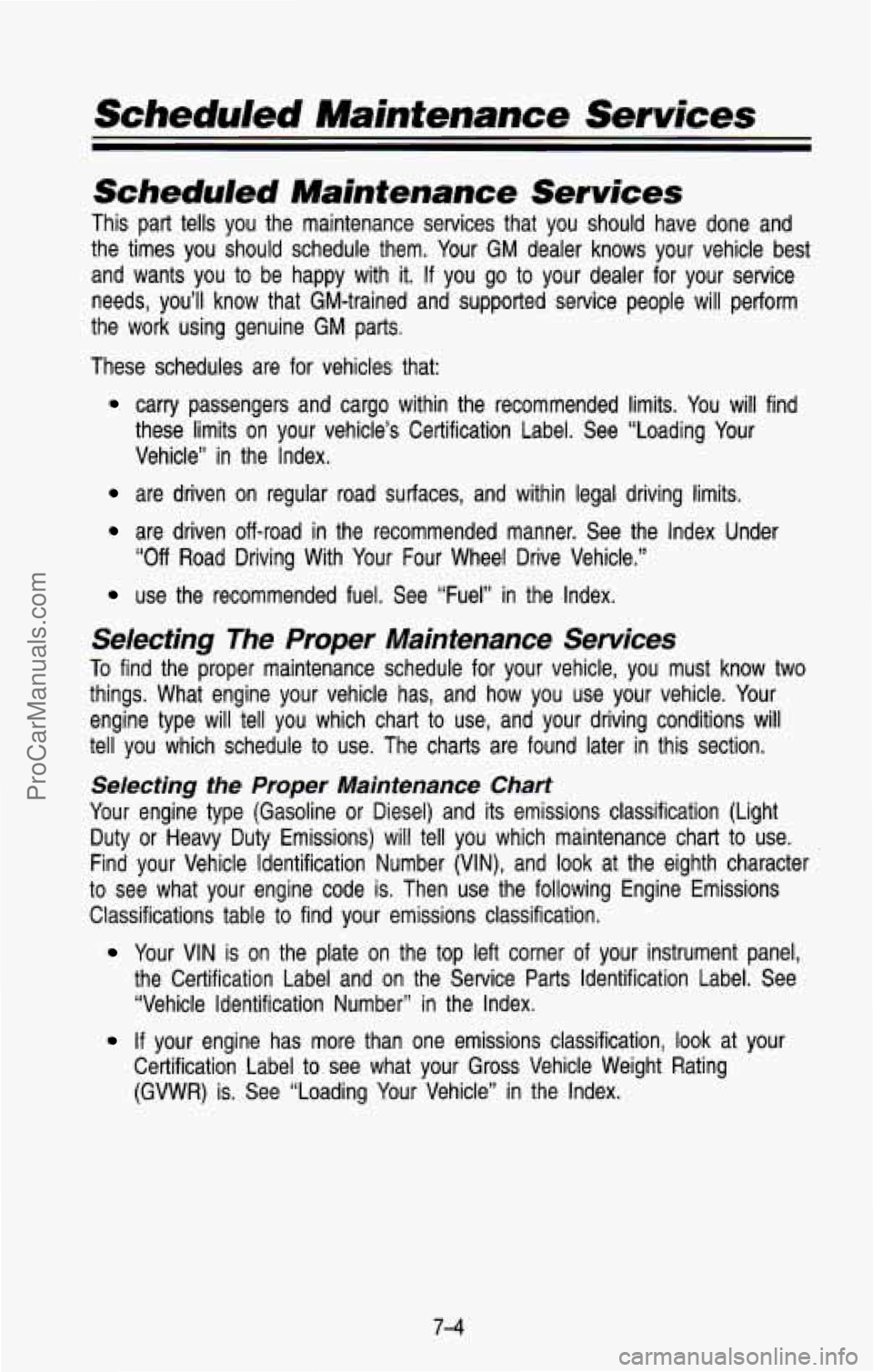
Scheduled Maintenance Services
Scheduled Maintenance Services
This part tells you the maintenance services that you should h\
ave done and
the times you should schedule them. Your
GM dealer knows your vehicle best
and wants you to be happy with it.
If you go to your dealer for your service
needs, you’ll know that GM-trained and supported service peop\
le will perform
the work using genuine GM parts.
These schedules are for vehicles that:
carry passengers and cargo within the recommended limits. You will find
these limits on your vehicle’s Certification Label. See “L\
oading Your
Vehicle” in the Index.
are driven on regular road surfaces, and within legal driving \
limits.
are driven off-road in the recommended manner. See the index Under
use the recommended fuel. See “Fuel” in the Index.
“Off Road Driving With Your Four Wheel Drive Vehicle.”
Selecting The Proper Maintenance Services
To find the proper maintenance schedule for your vehicle, you must know\
two
things. What engine your vehicle has, and how you use your ve\
hicle. Your
engine type will tell you which chart to use, and your driving conditions will
tell you which schedule to use. The charts are found later in this section.
Selecting the Proper Maintenance Chart
Your engine type (Gasoline or Diesel) and its emissions classification (L\
ight
Duty
or Heavy Duty Emissions) will tell you which maintenance chart to use.
Find your Vehicle Identification Number (VIN), and
look at the eighth character
to see what your engine code is. Then use the following Engine Emissions
Classifications table
to find your emissions classification.
Your VIN is on the plate on the top left corner of your instrument panel,
the Certification Label and on the Service Parts Identification Label. See
“Vehicle Identification Number” in the Index.
Certification Label to see what your Gross Vehicle Weight Rating
(GVWR) is. See “Loading Your Vehicle” in the Index.
If your engine has more than one emissions classification, look at your
7-4
ProCarManuals.com
Page 356 of 386
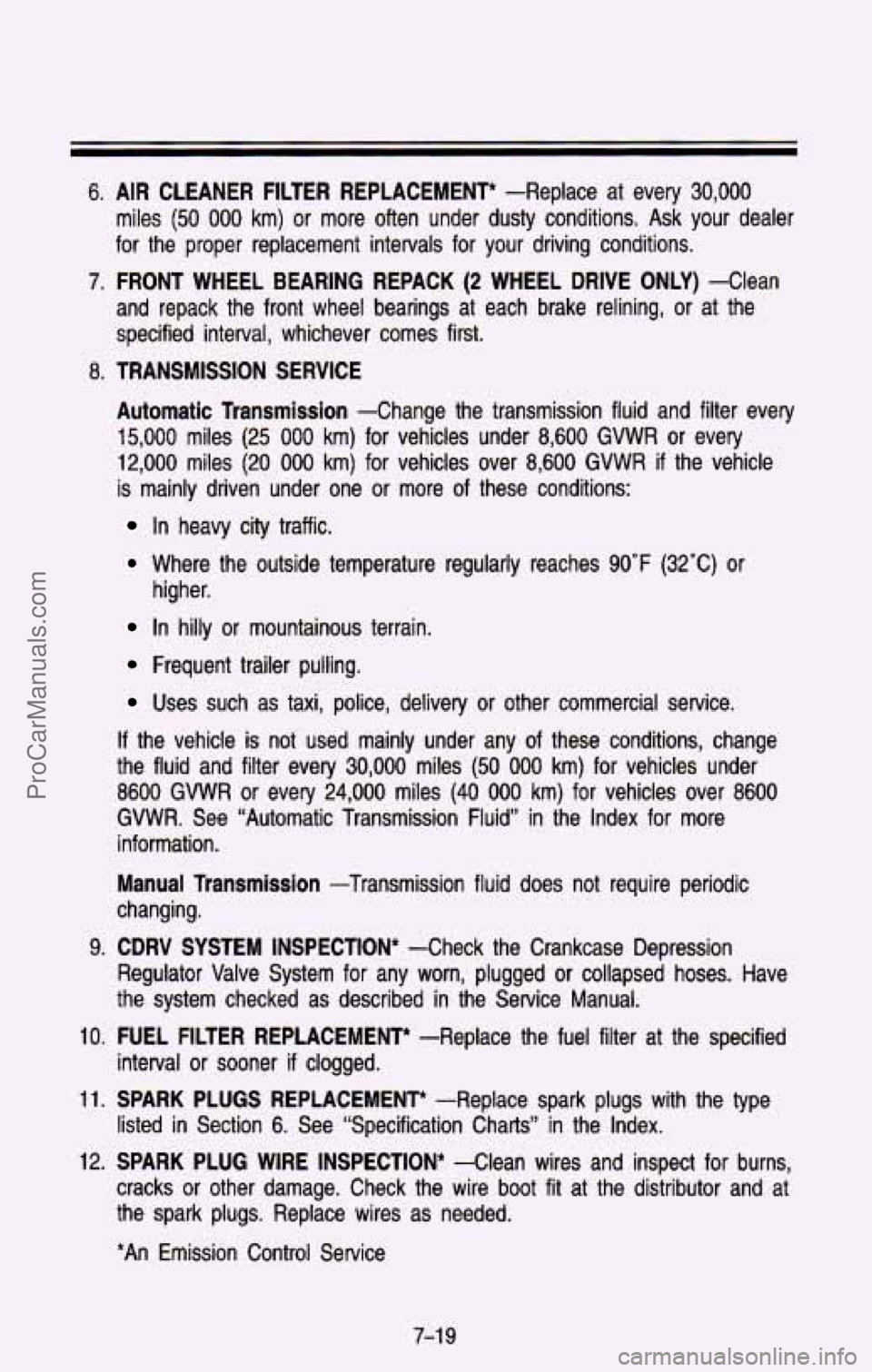
6. AIR CLEANER FILTER REPLACEMENT* -Replace at every 30,000
miles (50 000 km) or more often under dusty conditions. Ask your dealer
for the proper replacement intervals for your driving conditions\
.
7. FRONT WHEEL BEARING REPACK (2 WHEEL DRIVE ONLY) -Clean
and repack the front wheel bearings at each brake relining,
or at the
specified interval, whichever comes first.
8.
TRANSMISSION SERVICE
Automatic Transmission
-Change the transmission fluid and filter every
15,000 miles (25 000 km) for vehicles under 8,600 GVWR or every
12,000 miles
(20 000 km) for vehicles over 8,600 GVWR if the vehicle
is mainly driven under one
or more of these conditions:
In heavy city traffic.
Where the outside temperature regularly reaches 90°F (32°C) or
In hilly or mountainous terrain.
higher.
Frequent trailer pulling.
Uses such as taxi, police, delivery or other commercial service.
If the vehicle is not used mainly under any of these conditions, change
the fluid and filter every
30,000 miles (50 000 km) for vehicles under
8600 GVWR or every
24,000 miles (40 000 km) for vehicles over 8600
GVWR. See “Automatic Transmission Fluid” in the Index for more
information.
Manual Transmission -Transmission fluid does not require periodic
changing.
9. CDRV SYSTEM INSPECTION* -Check the Crankcase Depression
Regulator Valve System
for any worn, plugged or collapsed hoses. Have
the system checked as described in the Service Manual.
10. FUEL FILTER REPLACEMENT --Replace the fuel filter at the specified
interval
or sooner if clogged.
11.
SPARK PLUGS REPLACEMENT” --Replace spark plugs with the type
listed in Section
6. See “Specification Charts” in the Index.
12.
SPARK PLUG WIRE INSPECTION* -Clean wires and inspect for burns,
cracks
or other damage. Check the wire boot fit at the distributor and at
the spark plugs. Replace wires as needed.
*An Emission Control Service
7-1 9
ProCarManuals.com
Page 357 of 386
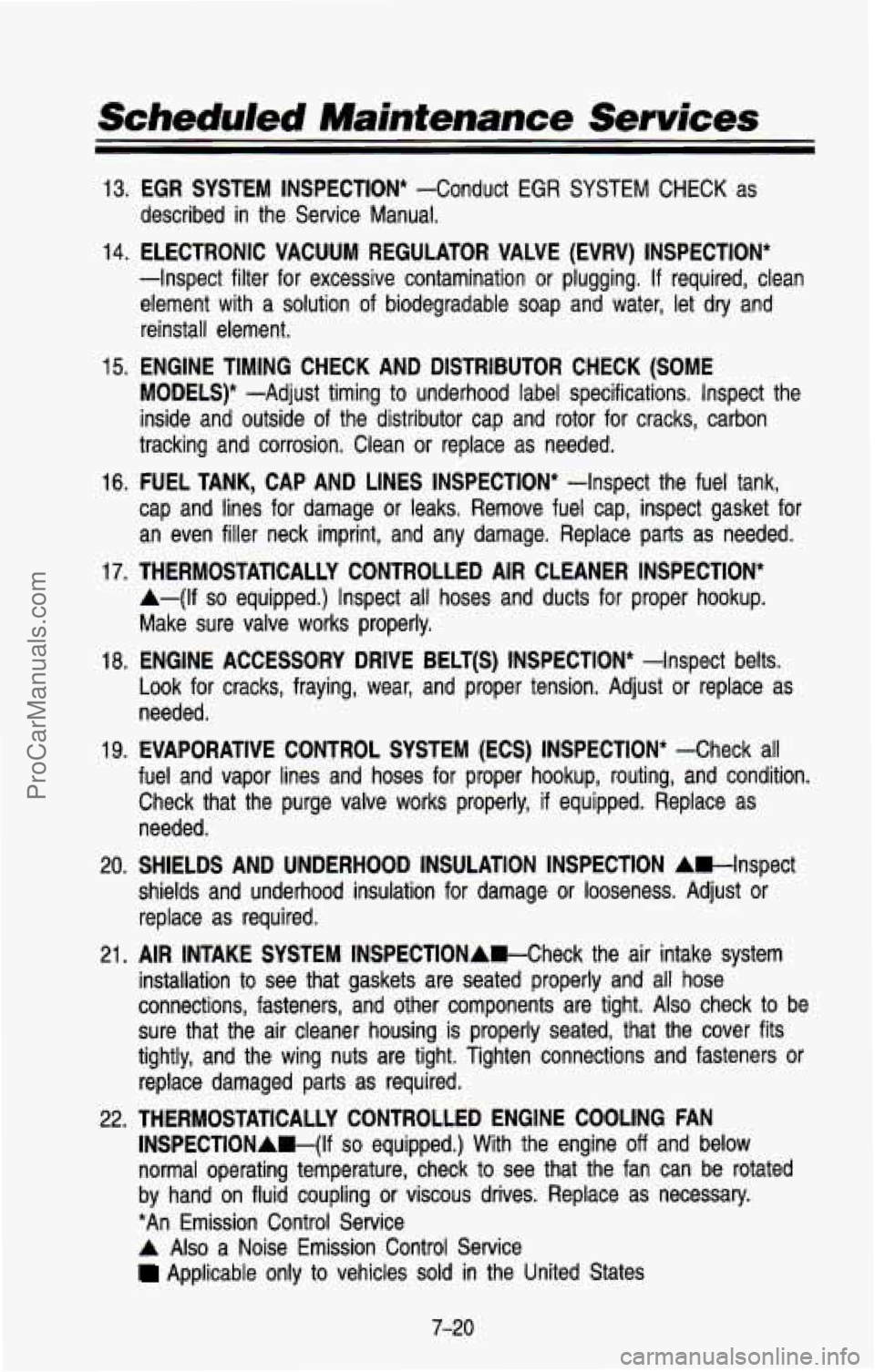
Scheduled Maintenance Services
13. EGR SYSTEM INSPECTION* -Conduct EGR SYSl /l CHECK as
described in the Service Manual.
14. ELECTRONIC VACUUM REGULATOR VALVE (EVRV) INSPECTION*
-Inspect filter for excessive contamination or plugging. If required, clean
element with a solution of biodegradable soap and water, let
dry and
reinstall element.
MODELS)* -Adjust timing to underhood label specifications. Inspect the
inside and outside of the distributor cap and rotor for cracks, carbon
tracking and corrosion. Clean or replace as needed.
15. ENGINE TIMING CHECK AND DISTRIBUTOR CHECK (SOME
16. FUEL TANK, CAP AND LINES INSPECTION* -Inspect the fuel tank,
cap and lines
for damage or leaks. Remove fuel cap, inspect gasket for
an even filler neck imprint, and any damage, Replace parts as needed.
17.
THERMOSTATICALLY CONTROLLED AIR CLEANER INSPECTION*
A-(If so equipped.) Inspect all hoses and ducts for proper hookup.
Make sure valve works properly.
Look for cracks, fraying, wear, and proper tension. Adjust or replace as
needed.
19. EVAPORATIVE CONTROL SYSTEM (ECS) INSPECTION* -Check all
fuel and vapor lines and hoses for proper hookup, routing, and\
condition.
Check that the purge valve works properly, if equipped. Replace\
as needed.
20.
SHIELDS AND UNDERHOOD INSULATION INSPECTION Awlnspect
shields and underhood insulation for damage or looseness. Adjust
or
replace as required.
installation to see that gaskets are seated properly and all hose
connections, fasteners, and other components are tight.
Also check to be
sure that the air cleaner housing is properly seated, that the\
cover
fits
tightly, and the wing nuts are tight. Tighten connections and \
fasteners or
replace damaged parts as required.
18. ENGINE ACCESSORY DRIVE BELT(S) INSPECTION* --Inspect belts.
21.
AIR INTAKE SYSTEM INSPECTlONAWCheck the air intake system
22. THERMOSTATICALLY CONTROLLED ENGINE COOLING FAN INSPECTIONAB-(If
so equipped.) With the engine off and below
normal operating temperature, check
to see that the fan can be rotated
by hand on fluid coupling or viscous drives. Replace as necessary.
*An Emission Control Service
A Also a Noise Emission Control Service
Applicable only to vehicles sold in the United States
7-20
ProCarManuals.com
Page 360 of 386
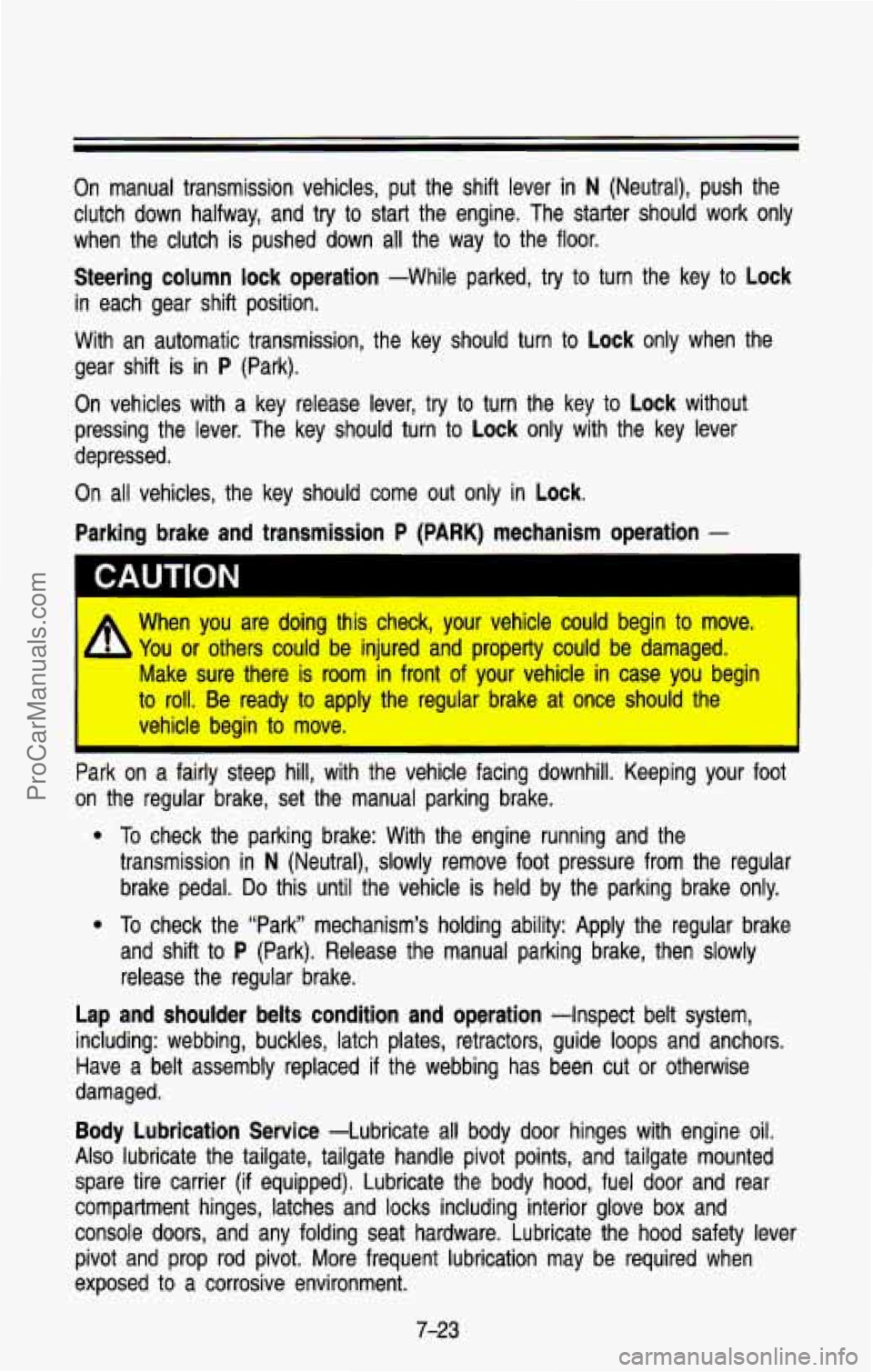
On manual transmission vehicles, put the shift lever in N (Neutral), push the
clutch down halfway, and try
to start the engine. The starter should work only
when the clutch is pushed down all the way to the floor.
Steering column lock operation -While parked, try to turn the key to Lock
in each gear shift position.
With an automatic transmission, the key should turn to
Lock only when the
gear shift is in
P (Park).
On vehicles with a key release lever,
try to turn the key to Lock without
pressing the lever. The key should turn to
Lock only with the key lever
depressed.
On all vehicles, the key should come out only in
Lock.
Parking brake and transmission
P (PARK) mechanism operation -
A
When you are doing this check, your vehicle could begin to move.
You
or others could be injured and property could be damaged.
Make sure there
is room in front of your vehicle in case you begin
to roll. Be ready to apply the regular brake at once should the
vehicle begin to move.
Park on a fairly steep hill, with the vehicle facing downhill. Keeping yo\
ur foot
on the regular brake, set the manual parking brake.
CAUTION
To check the parking brake: With the engine running and the
transmission in
N (Neutral), slowly remove foot pressure from the regular
brake pedal.
Do this until the vehicle is held by the parking brake only.
To check the “Park” mechanism’s holding ability: Apply the \
regular brake
and shift to
P (Park). Release the manual parking brake, then slowly
release the regular brake.
Lap and shoulder belts condition and operation -Inspect belt system,
including: webbing, buckles, latch plates, retractors, guide loop\
s and anchors.
Have a belt assembly replaced if the webbing has been cut or otherwise
damaged.
Body Lubrication Service -Lubricate all body door hinges with engine oil.
Also lubricate the tailgate, tailgate handle pivot points, and \
tailgate mounted
spare tire carrier
(if equipped). Lubricate the body hood, fuel door and rear
compartment hinges, latches and locks including interior glove b\
ox and
console doors, and any folding seat hardware. Lubricate the hoo\
d safety lever
pivot and prop rod pivot.
More frequent lubrication may be required when
exposed to a corrosive environment.
7-23
ProCarManuals.com
Page 363 of 386
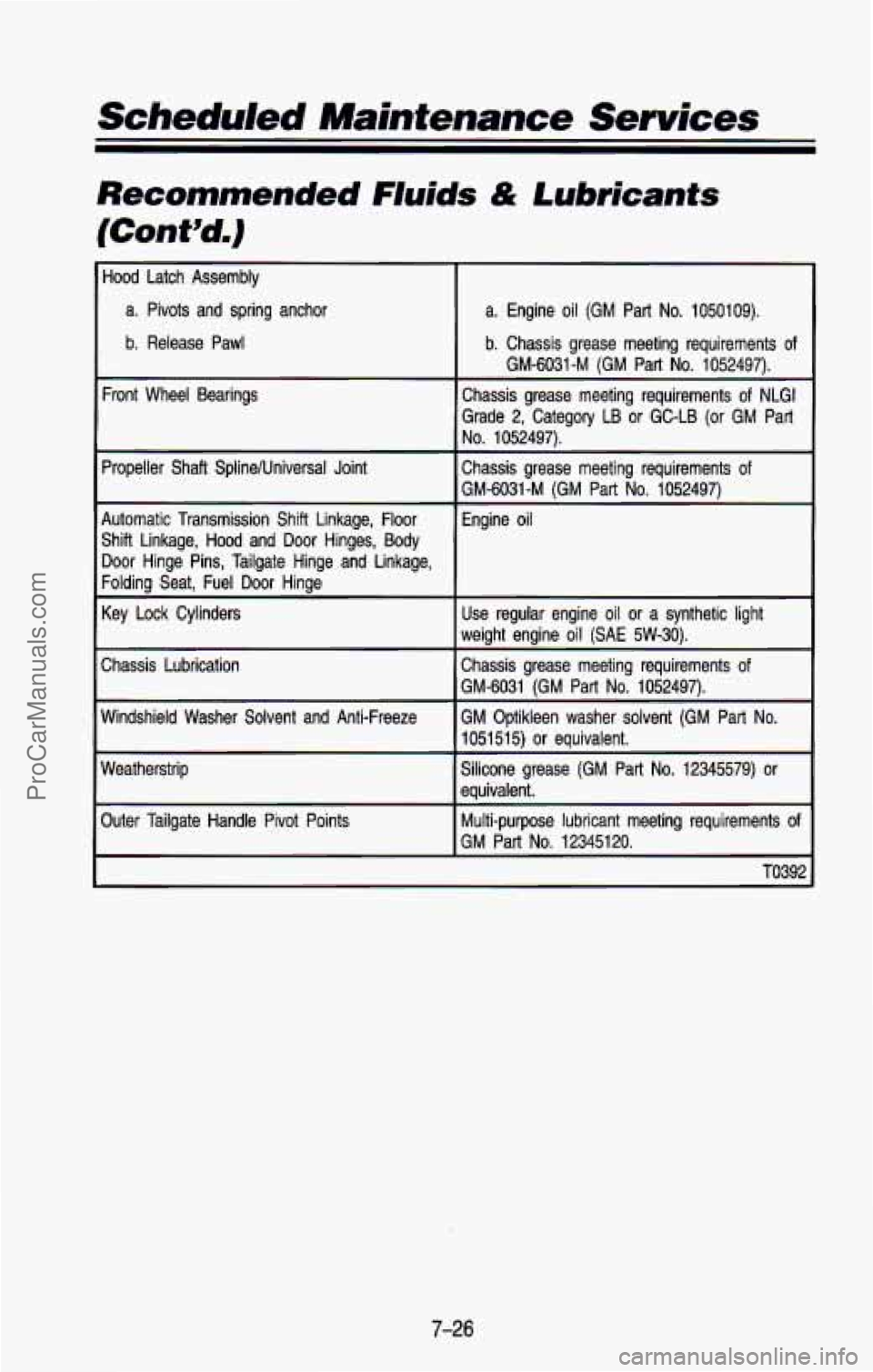
Scheduled Maintenance Services
Recommended Fluids & Lubricants
(Cont’d.)
Hood Latch Assembly
a. Pivots and spring anchor b. Release Pawl
Front Wheel Bearings
Propeller
Shaft SplinelUniversal Joint
Automatic Transmission Shift Linkage, Floor
Shift Linkage,
Hood and Door Hinges, Body
Door Hinge Pins, Tailgate Hinge and Linkage,
Folding Seat, Fuel Door Hinae Key Lock Cylinders
Chassis Lubrication
Nindshield Washer Solvent and Anti-Freeze
Neatherstrip
Mer Tailgate Handle Pivot Points a. Engine
oil (GM Part
No. 1050109).
b. Chassis grease meeting requirements
of
GM-6031-M (GM Part No. 1052497).
Chassis grease meeting requirements
of NLGl
Grade 2, Category
LB or GC-LB (or GM Part
No. 1052497).
Chassis grease meeting requirements
of
GM-6031-M EM Part No. 10524971
Engine oil
Use regular engine
oil or a synthetic light
weiaht enaine
oil [SAE 5W-30).
Chassis grease meeting requirements
of
GM-6031 (GM Part No. 1052497).
GM Optikleen washer solvent
(GM Part No.
1051515) or equivalent.
Silicone grease
(GM Part No. 12345579) or
equivalent.
Multi-purpose lubricant meeting requirements
of
GM Part No. 123451 20.
TO392
7-26
ProCarManuals.com
Page 365 of 386
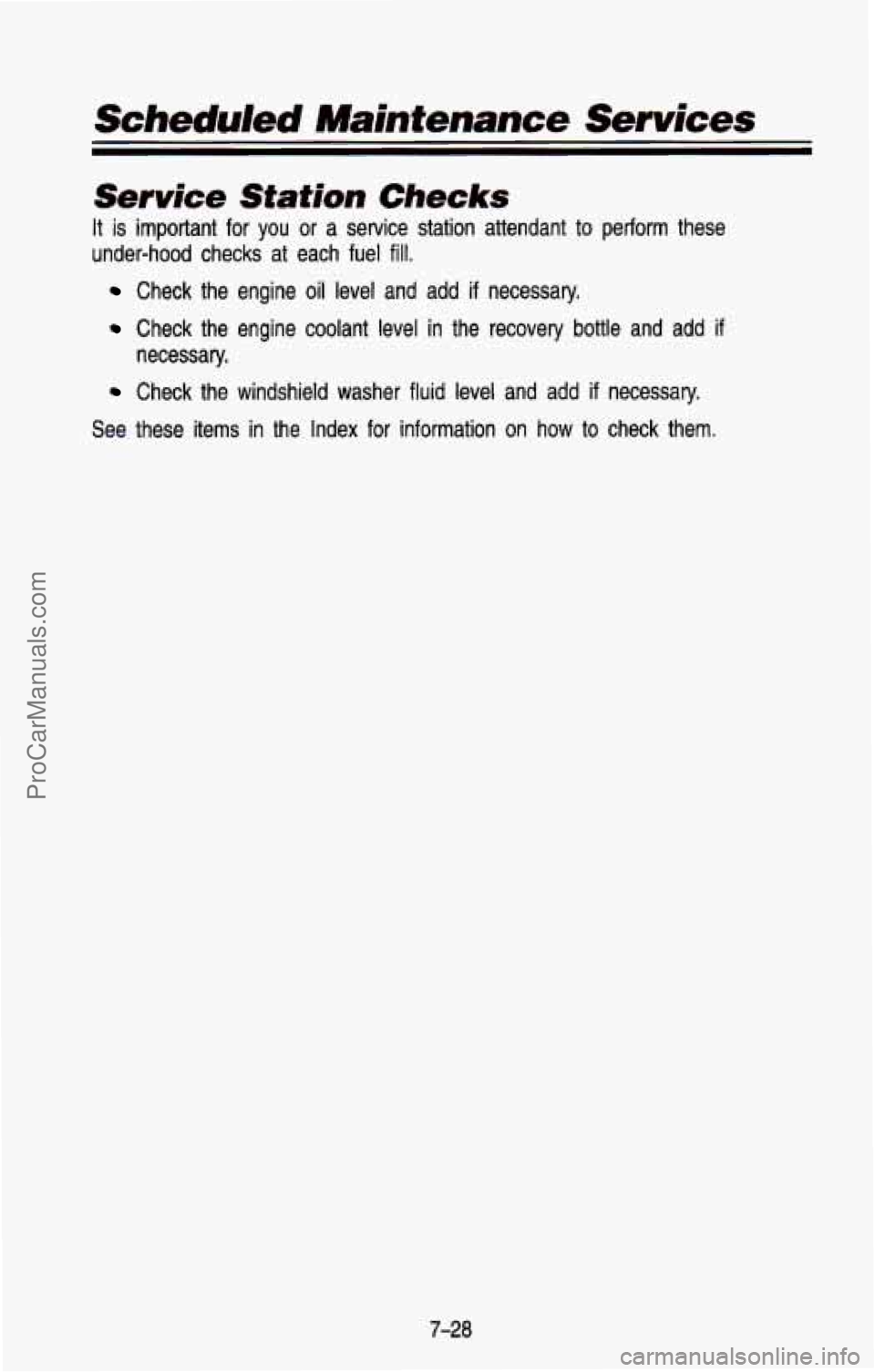
Scheduled Maintenance Services
Service Station Checks
It is important for you or a service station attendant to perform these
under-hood checks at each fuel
fill.
Check the engine oil level and add if necessary.
Check the engine coolant level in the recovery bottle and add \
if
Check the windshield washer fluid level and add if necessary.
necessary.
See these items in the Index
for information on how to check them.
ProCarManuals.com
Page 378 of 386

Skidding ..................................... 4-23
Stuck
in Deep Snow .... 4-56, 5-31
Through Water
............... 2-1 5, 4-34
Uphill
.......................................... 4-28
Winter
........................................ 4-53
With a Trailer
............................ 4-60
Drunken Driving
........................... 4-1 0
E
Electrical System ......................... 6-37
Add-on Equipment
................... 6-67
Engine
Adding Coolant
... 5-1 1, 5-13, 6-27
Air Cleaner
................................ 6-1 6
Block Heater
.......... 2-16, 3-5, 6-16
Computer Command Control
System
..................................... 6-45
Coolant
............................ 6-25, 6-68
Coolant Temperature Gage
...... 2-77
Cooling System
......................... 5-10
Crankcase .................................. 6-69
Exhaust
..................................... 2-28
Fan Noise
.................................. 5-1 6
Identification
................... 6-65, 6-68
Leaving Vehicle While Running
....................... 2-26
Oil (See
“Oil”)
Overheating ................................. 5-8
Running While Parked
............. 2-29
Starting
...................................... 2-1 4
Equipment, Add-on
...................... 6-48
Exhaust System
........................... 6-45
F
Fan Noise ...................................... 5-1 6
Filter Replacement Chart
............ 6-69
Finish
Care
............................................ 6-61
Damage
..................................... 6-62
Automatic Transmission
........... 6-17
Brake
.......................................... 6-32
Fluid Capacities
.................................. 6-68
Coolant
....................................... 5-11
Front Axle ................................. 6-24
Hydraulic
Clutch ....................... 6-21
Leak Check
............................... 6-35
Manual Transmission
............... 6-20
Power Steering
......................... 6-29
Radiator
..................................... 5-13
Rear Axle
.................................. 6-24
Recommended Fluids
.............. 7-25
Transfer Case
............................ 6-23
Windshield Washer
........ 2-40, 6-31
Four-wheel Drive
............... 2-30, 6-23
Transfer Case
................. 2-30, 6-23
Front Axle
..................................... 6-24
Fuel
.................................................. 6-4
Filling Your Tank
......................... 6-6
Foreign Countries
....................... 6-6
Gage
.......................................... 2-76
Gasolines
for Cleaner Air ......... 6-5
Tank Capacity
........................... 6-69
Fuses and Circuit Breakers
.......... 6-43
Fuse Block
................................ 6-44
Headlights
................................. 6-43
Power Windows and
Other Power Options
........... 6-44
Trailer Wiring Harness
............. 6-44
Windshield Wipers
................... 6-44
G
Gages .................................. 2-66, 2-76
Coolant Temperature Gage
..... 2-77
Fuel Gage
.................................. 2-76
Odometer
................................... 2-66
Oil Pressure Gage
.................... 2-78
Speedometer
............................. 2-66
Tachometer
................................ 2-67
Trip Odometer
........................... 2-67
Voltmeter
................. ................. 2-79
Glove Box
..................................... 2-56
9-3
ProCarManuals.com